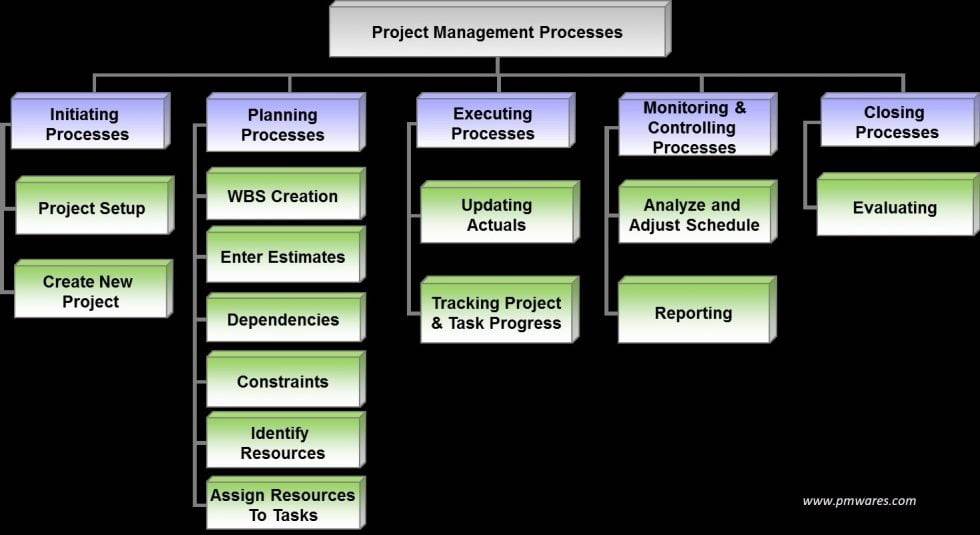Mapping MS Project 2016 to project management processes

Microsoft Project is the tool which is used throughout the project life cycle from initiation to closure. Let’s see how various features of MS Project 2016 are used at various stages of the projects and how project 2016 helps in adhering to project management processes. Above figure shows the relationship between project management process groups and Microsoft Project. The figure also gives an understanding how we have to use Microsoft Project at various stages of project life cycle.
Initiation:
We need to setup MS Project 2016 if we are using MS Project 1st time or we have not created a template from our earlier executed projects. At the start of a project we need to induct MS Project to our project environment vary similar to how we induct a new team member to our project. In the File -> Options, we should setup some basic options like date format, currency that will be used for project costing, office timing, duty ours on a typical day, number of working hours in a week, number of working days in a month, unit of measurement for duration and work etc. This way we customize MS Project to work in our environment.
Planning:
For a smooth execution, plan has to be of excellent quality. With respect to Microsoft Project, a lot of work is done at planning stage. We create a Work Breakdown Structure (WBS) by breaking down product and project work into smaller pieces up to activity level, enters duration or efforts estimates for each activity, establish dependencies among activities, identify constraints and minimize them as much as possible. We also identify all types of resources (man, machines, material & money), make a list of resources with all the details such as their availability, unit of measure, their standard rates etc. After creating a list of resources, we assign them to activities based on who will do what and what all resources are required to accomplish the work. Once the plan is ready, we optimize the plan by adjusting estimates, discretionary dependencies and resource assignments. If the total duration of the schedule is more than expected then we crash or fast track the project to reduce its duration. Here feasibility is an important aspect to consider. We are preparing plan that our team will execute. If we crash or fast track the project beyond the feasible limits, our team will not be able to carry out the work as per plan and then such a plan will only be a paper work because it cannot be executed. We have to prepare a plan that is practical and executable. Even if it means going beyond imposed deadlines. We need to negotiate deadlines with stakeholders to keep the plan realistic and executable to deliver the outcome as promised.
Execution:
Execution is the stage where we have full team on board. While the whole team is working to produce deliverables, our main responsibility is to guide the team, remove the potential road blocks and from MS Project 2016 point of view, collect the work performance data to update the project schedule with actuals.
The actual data should be collected right from the team member who has performed the work. We should not only collect the data about progress so far but also the forecast. Suppose an activity is estimated to take 10 days. As of now 5 days of work is completed. It does not mean that the remaining work will be completed in next 5 days. It can be less or more depending up on experience of team members and progress made in last five days. Once we have collected actual data of the progress made so far and forecast, we update these actuals in MS Project.
Monitoring and Control
Now we have got actual data in the MS Project, we should generate reports. Microsoft Project specially MS Project 2013 and MS Project 2016 provide a very flexible way of generating reports. Based on requirements of our status meeting and various stakeholders, we should prepare various report templates. There are some readymade templates available which we can customize or we can take a completely blank canvas and add tables, graphs, text boxes, pictures, shapes etc. to prepare a template that satisfies stakeholders of our project.
Reports help us to understand if we are on time & budget or there is any variance? With these reports we can conduct our project status meetings and discuss with stakeholders to analyze and identify root causes. Based on root cause, we can decide on corrective and preventive measures. These corrective and preventive measures will be updated in project plan to carry out the work in execution as per updated plan.
Closure
MS Project 2016 helps us on two aspects of project closure. The first is lesson learned. Throughout the project we have collected actual data and updated MS Project. This is the time to look back. Using various views, tables and reports we can analyze what went well and what did not go well. Using MS Project we can compile a report and present lesson learned to stakeholders.
Second is archive the data. We have a very valuables data with us. If we archive the data in such a way that can be easily searched and used, we can use it if we get a project in future which is similar to this project.
PMI, PMBOK and PMP are registered mark of Project Management Institute Inc.